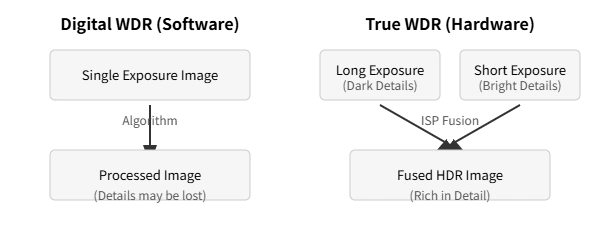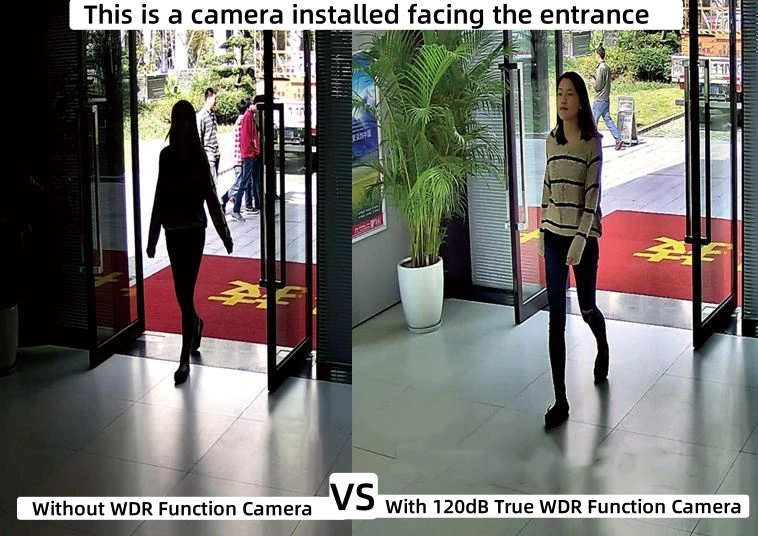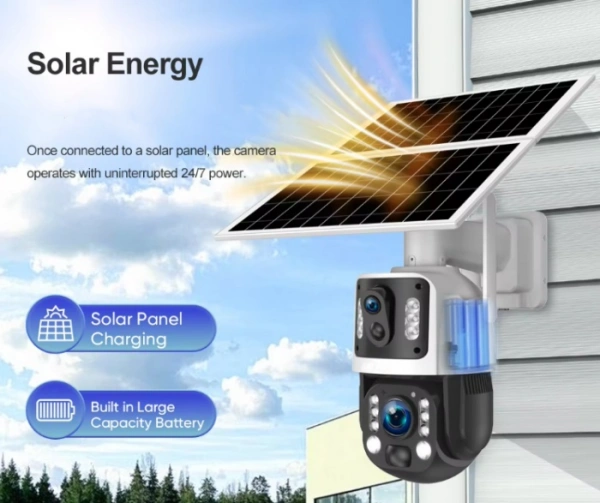Digital WDR vs. True WDR: An Engineer Explains Why Your Camera Sees “Washed-Out Whites & Pitch-Black Shadows”
You’ve definitely seen this security footage before: a person walks into a lobby from outside, and because of the bright light behind them, their entire body and face become an unrecognizable black silhouette. Or, a camera is pointed at a window, and while the view outside is clear, the room’s interior is too dark to see anything.
This problem of “washed-out highlights and pitch-black shadows” is one of the most common pain points in video security. The core technology that solves this is Wide Dynamic Range (WDR). But WDR is split into two types, “Digital WDR (DWDR)” and “True WDR,” and the difference between them is night and day.
The core difference between Digital WDR and True WDR lies in their technical principles and dynamic range:
- Digital WDR (DWDR): Enhances image contrast via software algorithms (typically in the 30-80dB range).
- True WDR: Utilizes multi-frame exposure and hardware-based synthesis (typically in the 110-120dB range).
Difference in Technical Principle
Digital WDR:
It uses the Image Signal Processor (ISP) to adjust the local contrast of a single frame. This technique relies on post-processing algorithms to optimize the visibility of bright and dark areas, essentially enhancing detail through grayscale mapping.
True WDR (also known as Optical WDR):
It employs a sensor capable of multiple exposures (such as a dual-output CCD or a multi-exposure CMOS). Within the same moment, it rapidly captures two or more images at different exposure times: a long exposure to capture shadow details and a short exposure to preserve highlight information.
These frames are then fused at the hardware level to achieve a more natural balance between light and shadow, avoiding the detail distortion common with software-only algorithms.
Dynamic Range
- Digital WDR: 30-80dB, suitable for general backlit scenes.
- True WDR: 110-120dB (e.g., found in Hikvision’s Starlight series), capable of handling environments with extreme light contrast.
First, What is “Dynamic Range”? Why Your Eyes See Clearly, But Cameras Don’t
Imagine you’re standing inside a room looking out a window. You can see the details of the furniture inside and the landscape outside simultaneously. This is because your eyes have an incredibly high “dynamic range,” allowing them to instantly adjust and process both extremely bright and dark light information at once.
A camera’s image sensor (CMOS), however, is like a canvas with limited capabilities. At any given moment, it can only choose one exposure level. It can either increase the exposure to see the dark areas, which causes the bright areas to become “overexposed” (pure white), or it can decrease the exposure to see the bright areas, which causes the dark areas to become “underexposed” (pure black). A camera’s ability to “see” the brightest and darkest parts of a scene at the same time is its dynamic range.
Digital WDR (DWDR): The Smart “Software Enhancer”
Digital Wide Dynamic Range (DWDR) is an optimization technique based on a software algorithm.
- How It Works: It doesn’t change how the camera’s hardware operates. The camera still takes only one standard-exposure picture, resulting in an image with harsh light contrast. Then, the camera’s internal Image Signal Processor (ISP) acts like a “photo-editing software,” using an algorithm to artificially boost the brightness of the dark areas and lower the brightness of the bright areas. It then outputs a single image that looks a bit more balanced.
- The Pros: It’s very low-cost because it doesn’t require special hardware. Any camera can implement it via software.
- The Cons: The effect is limited. Because it’s “guessing” how to fix an image that has already lost information, it often leads to:
- Detail Loss: The artificially brightened shadows become noisy and blurry.
- Color Distortion: The image colors can look unnatural.
- Low Performance: In scenes with extreme light contrast, the effect is minimal.
In short, DWDR is a patch-up job, trying its best to salvage a poorly captured photo.
True WDR: The Hardware-Based Imaging Scientist
True WDR, sometimes called Optical WDR, is a solution based on advanced hardware and algorithms.
- How It Works: It solves the problem at the source. An image sensor with True WDR capability captures two or more frames of the same scene in rapid succession at different exposure levels:
- A long exposure: to capture details in the dark areas.
- A short exposure: to capture details in the bright areas.
The powerful ISP then takes these frames, each containing different details, and perfectly fuses them into a single, new, high dynamic range image.
- The Pros: The results are outstanding. Because it’s working with real light information, the final image has:
- Rich Detail: Details in both the bright and dark areas are crystal clear.
- Natural Look: Colors and brightness are smooth and closely resemble what the human eye sees.
- Powerful Capability: It easily handles extreme contrast scenes like doorways, lobbies, and tunnels.
- The Cons: It’s more expensive because it requires a more powerful image sensor and ISP chip to handle the high-speed multi-exposure and complex fusion process.

Decoding the Key Spec: What Does “120dB” Mean?
You’ll often see a “dB” value, like 120dB, listed for True WDR cameras. This dB (decibel) value is the standard for measuring WDR capability. It represents the ratio between the brightest and darkest signals the camera can handle. The higher the number, the stronger the WDR capability and the greater the light contrast it can manage.
Generally, a 120dB True WDR provides excellent performance and is a hallmark of a high-quality security camera.
The Ultimate Showdown: A Table to Understand All the Differences
| Feature | Digital WDR (DWDR) | True WDR |
|---|---|---|
| Principle | Software algorithm post-processing | Hardware (sensor) multi-exposure + fusion |
| Exposures | 1 | 2 or more |
| Effect | Limited, potential for noise/distortion | Excellent, clear details, natural image |
| Cost | Low | High |
| Core Concept | “Fixing” a photo | “Creating” a photo |
| Best For | Low-contrast indoor scenes | High-contrast, backlit scenes (entrances, etc.) |
Which WDR Do I Actually Need? An Engineer’s Scene-by-Scene Advice
- When to Choose Digital WDR (DWDR): If your camera is monitoring an area with relatively even lighting, like an office interior, living room, or bedroom, DWDR is generally sufficient and can be a nice bonus feature.
- When You MUST Choose True WDR: If your camera needs to be pointed at any of the following locations, True WDR is your only reliable choice:
- Store / Restaurant / Office Entrances: To clearly see the faces of people entering and exiting.
- Parking Garage / Car Park Exits: To capture license plates of vehicles against daylight.
- Lobbies or Living Rooms with Large Windows: To see both the interior and exterior clearly.
- Tunnel Entrances and Exits: To manage the extreme light difference between inside and out.
Conclusion: Software Has Its Limits, Hardware Determines the Results
To sum it up, Digital WDR is an economical “patch,” while True WDR is a fundamental “solution.” DWDR is a nice-to-have feature, but True WDR is the must-have that solves a critical problem when you need it most.
2025 newest 36X Zoom in/out solar powered security camera for farm/construction site/job site


